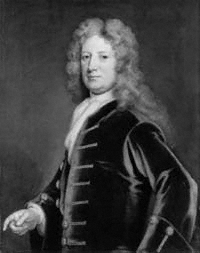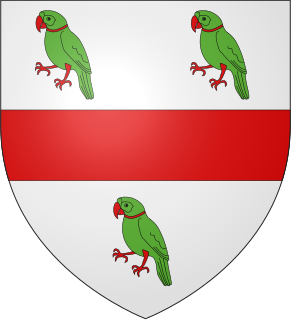Related Research Articles

Baron Audley is a title in the Peerage of England first created in 1313, by writ to the Parliament of England, for Sir Nicholas Audley of Heighley Castle, a member of the Anglo-Norman Audley family of Staffordshire.

Baron de Ros of Helmsley is the premier baron in the Peerage of England, created in 1288/89 for William de Ros, with precedence to 24 December 1264. Premier baron is a designation and status awarded to the holder of the most ancient extant barony of the Peerage of England. The present premier baron is Baron de Ros. Before the Dissolution of the Monasteries the Prior of the Order of St John in England was deemed premier baron.

Baron Mowbray is a title in the Peerage of England. It was created by writ for Roger de Mowbray in 1283. It was held for a long time by the Mowbray and Howard Dukes of Norfolk. The title was united with the Barony of Segrave in 1368, when John Mowbray, 1st Earl of Nottingham and 5th Baron Mowbray succeeded to that title. Then, it became united with the Dukedom of Norfolk. The two titles were frequently separated due to the attainders of the dukes of Norfolk, and were later reunited upon the dukes' restorations. The final separation occurred with the death of the ninth duke, when the barony of Mowbray fell into abeyance. Thereafter, it was united with the Barony of Stourton after it, and the barony of Segrave, were brought out of abeyance in the nineteenth century in favour of the twentieth Baron Stourton. The baronies of Mowbray and Segrave were shortly separated, as the barony of Segrave was called out of abeyance about two weeks after the barony of Mowbray. The Mowbray barons become premier barons of England when the only older title, that of the Barony of de Ros, is held by a woman.
Baron Strabolgi is a title in the Peerage of England supposedly created in 1318 for Scottish lord David of Strathbogie, 10th Earl of Atholl. Despite lack of evidence supporting its existence, it was called out of abeyance by the House of Lords in 1916. Whether it ever existed before then is open to serious dispute.

Baron Wharton is a title in the Peerage of England, originally granted by letters patent to the heirs male of the 1st Baron, which was forfeited in 1729 when the last male-line heir was declared an outlaw. The Barony was erroneously revived in 1916 by writ of summons, thanks to an 1844 decision in the House of Lords based on absence of documentation. As such, the current Barony of Wharton could more accurately be listed as a new Barony, created in 1916, with the precedence of the older Barony.

Baron Berners is a barony created by writ in the Peerage of England.

Baron Braye, of Eaton Bray in the County of Bedford, is a title in the Peerage of England. It was created in 1529 for Edmund Braye, 1st Baron Braye. However the family originally originate from Normandy, they are direct descendants of Chevalier Baudry de Bray who came over to England in the battle of Hastings of 1066. The barony was created by writ, which means that it can descend through both male and female lines. He was succeeded by his son, the second Baron. He died from wounds received at the Battle of St Quentin in 1557. Lord Braye was childless and on his death the title fell into abeyance between his sisters.
Baron Cromwell is a title that has been created several times in the Peerage of England. The first creation, which was by writ, was for John de Cromwell in 1308. On his death, the barony became extinct. The second creation came in 1375 when Ralph de Cromwell was summoned by writ to Parliament as Lord Cromwell. His grandson, the third baron, served as Lord High Treasurer to King Henry VI. However, on his death in 1455 the barony fell into abeyance between his nieces Maude and Joan. On Joan's death in 1490 the abeyance was terminated in favour of Maude, the fourth holder. When she died childless in 1497 the peerage once again fell into abeyance, this time between the daughters of the first baron. The title remained in abeyance for over 400 years. However, in 1922 the Committee for Privileges of the House of Lords reported in favour of the petition for the termination of the abeyancy of Selina Frances Bewicke-Copley. She was the daughter of Sir Charles Watson Copley, 3rd Baronet, and one of the co-heirs of Maud, daughter of the first baron Cromwell. Selina died in 1923 and in July of the same year the abeyance was terminated in favour of her son Robert Godfrey Wolesley Bewicke-Copley, who became the fifth baron. He notably served as Lord Lieutenant of Leicestershire. As of 2010 the ancient barony is held by his grandson, the seventh baron, who succeeded his father in 1982. Having lost his seat in the House of Lords under the House of Lords Act 1999, in April 2014 he was elected at a hereditary peers' by-election as a Crossbencher.
Baron Darcy de Knayth is a title in the Peerage of England. It was created in 1332 for John Darcy with remainder to his heirs general, allowing daughters to inherit.

Baron le Despencer is a title that has been created several times by writ in the Peerage of England.
Baron Fauconberg is an hereditary title created twice in the Peerage of England.
Baron Wake of Liddell is an abeyant title in the Peerage of England. It was created in 1295 for John Wake. It has been in abeyance since 1408.
Baron Stanley is an abeyant title in the Peerage of England. It was created in 1456 for Sir Thomas Stanley. His son was created Earl of Derby in 1485 and the titles remained united until the death of the fifth earl, without male heirs in 1594, when the barony became abeyant. On 7 March 1921, the abeyance was terminated in favour of the 12th Countess of Loudoun, but upon her death in 1960, it became abeyant among her daughters.

Baron FitzHugh, of Ravensworth in North Yorkshire, is an abeyant title in the Peerage of England. It was created in 1321 for Sir Henry FitzHugh. The title passed through the male line until the death in 1513 of George FitzHugh, 7th Baron FitzHugh, when it became abeyant between his great-aunts Alice, Lady Fiennes and Elizabeth, Lady Parr, and to their descendants living today, listed below. The family seat was Ravensworth Castle in North Yorkshire, situated 4.5 miles north-west of Richmond Castle, caput of the Honour of Richmond, one of the most important fiefdoms in Norman England.
The barony of Hussey has been created three times in the Peerage of England. Of these, one creation is abeyant while the other two are extinct or forfeited respectively.

Sir Marmaduke Thweng, later 1st Baron Thweng, was an English knight from Yorkshire who fought in the Wars of Scottish Independence.

Baron FitzWarin is an abeyant title in the Peerage of England. It was created by Writ of summons for Fulk V FitzWarin in 1295. His family had been magnates for nearly a century, at least since his grandfather Fulk III FitzWarin had recovered Whittington Castle in 1205. This castle near Oswestry was their main residence and the seat of a marcher lordship. It was regarded as situated in the county of Shropshire since 1536 and also in the Domesday Book of 1086, but for much of the intervening period was regarded as part of Wales.

James Audley, 2nd Baron Audley of Heighley Castle, Staffordshire, was an English peer. He was the son and heir of Nicholas Audley, 1st Baron Audley (1289–1316) by his wife Joan FitzMartin, who was the daughter of William FitzMartin, feudal baron of Barnstaple, and Marcher Lord of Kemes. She was posthumously the eventual sole heiress of her brother William FitzMartin to Barnstaple and Kemes.
Earl of Glengall was a title in the Peerage of Ireland that was created in 1816 for Richard Butler, 10th Baron Cahir. The subsidiary title of Baron Cahir in the Peerage of Ireland was first created in 1542 for Thomas Butler, who was a descendant of James Butler, 3rd Earl of Ormond. The title was re-created in 1583 with the unusual remainder to heirs general of the first baron, which made his great-nephews, Theobald Butler and Thomas Prendergast, co-heirs. Prendergast ceded the title to Theobald Butler, preferring that the title should follow the strict male line.

The title Baron Cobham has been created numerous times in the Peerage of England; often multiple creations have been extant simultaneously, especially in the fourteenth century. The earliest creation was in 1313 for Henry de Cobham, 1st Baron Cobham, lord of the manors of Cobham and of Cooling, both in the county of Kent. The de Cobham family died out in the male line in 1408, with the death of the 3rd Baron Cobham, but the title continued via a female line to the Brooke family, which originated at the estate of "la Brook" near Ilchester in Somerset, and which later resided at Holditch in the parish of Thorncombe and at Weycroft in the parish of Axminster, both in Devon, both fortified manor houses. Following their inheritance, the Brooke family resided at Cobham Hall and Cooling Castle in Kent. Henry Brooke, 11th Baron Cobham, was attainted in 1603, when the peerage became abeyant instead of becoming extinct. In 1916, the attainder was removed and the abeyance terminated in favor of the fifteenth baron. The twelfth to fourteenth barons never actually held the title. This creation became abeyant again in 1951.
References
- ↑ Burke, Sir Bernard (1866). "A Genealogical History of the Dormant: Abeyant, Forfeited, and Extinct Peerages of the British Empire". Harrison. p. 532. Retrieved 16 September 2016.
| This biography of a baron or baroness in the Peerage of England is a stub. You can help Wikipedia by expanding it. |